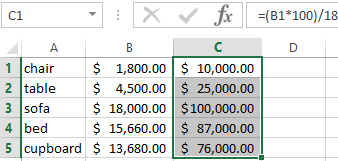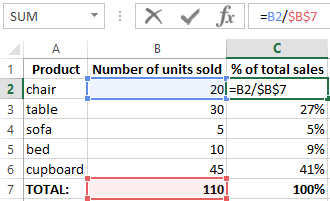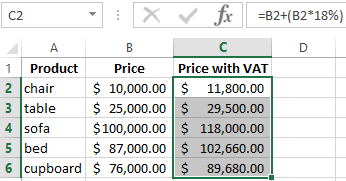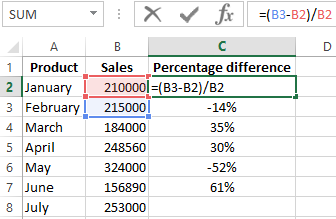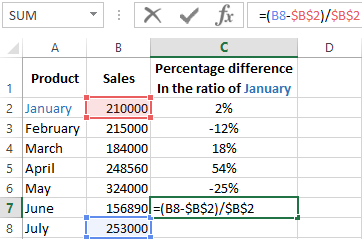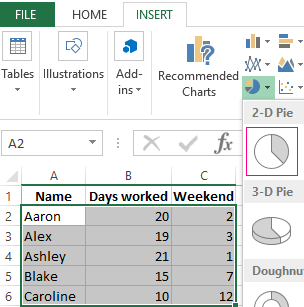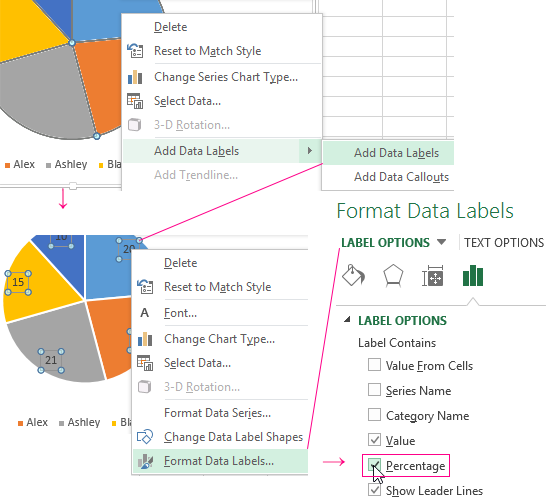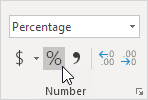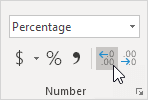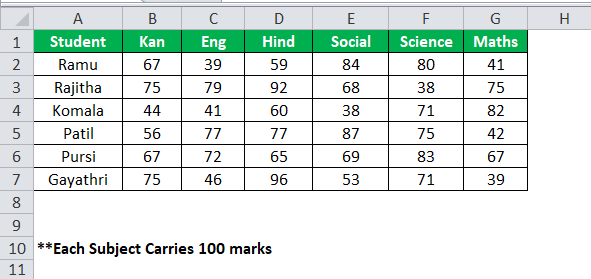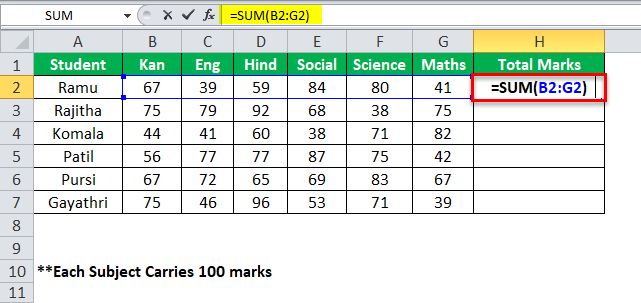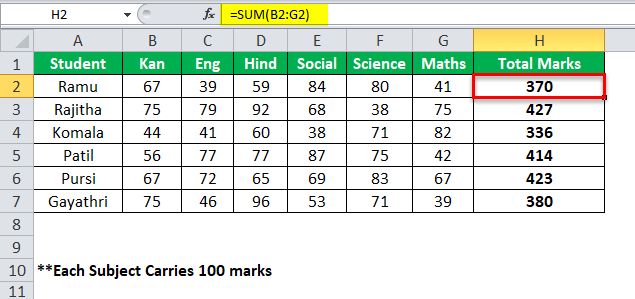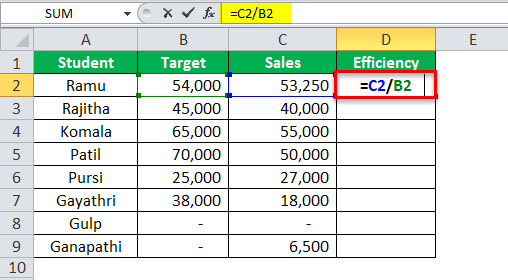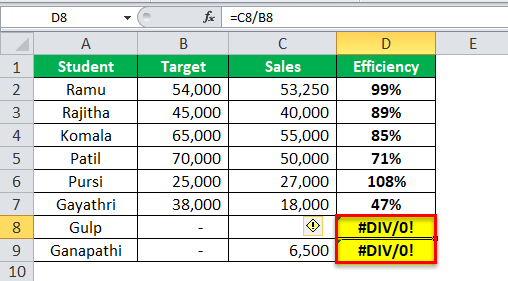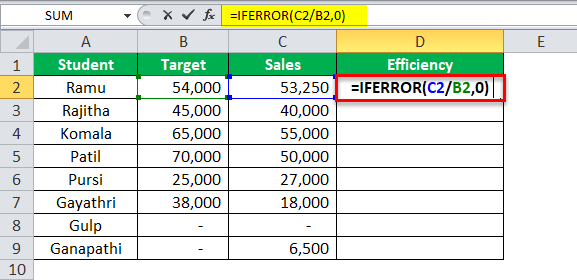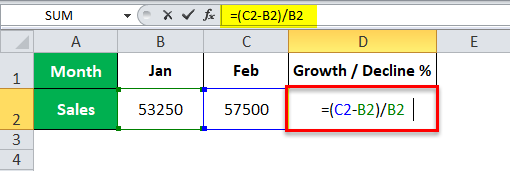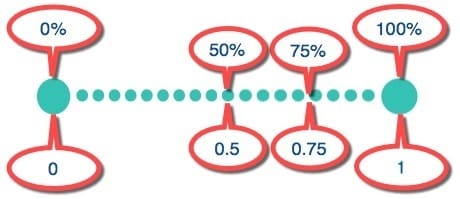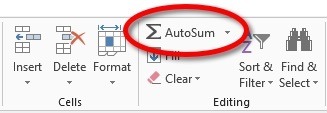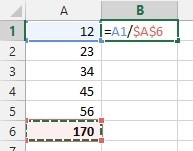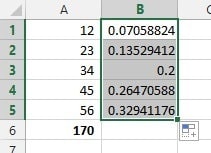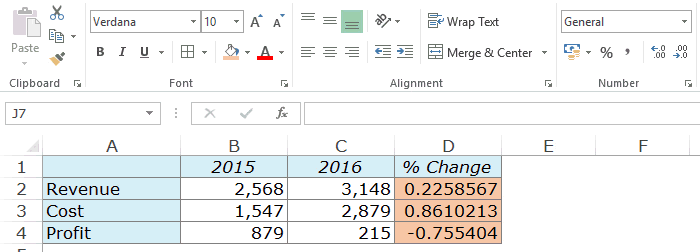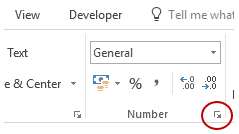Excel for Microsoft 365 Excel for Microsoft 365 for Mac Excel for the web Excel 2021 Excel 2021 for Mac Excel 2019 Excel 2019 for Mac Excel 2016 Excel 2016 for Mac Excel 2013 Excel 2010 Excel 2007 Excel for Mac 2011 More…Less
Sometimes percentages can be frustrating because it’s not always easy to remember what we learned about them in school. Let Excel do the work for you – simple formulas can help you find the percentage of a total, for example, or the percentage difference between two numbers.
Find the percentage of a total
Let’s say that you answered 42 questions out of 50 correctly on a test. What is the percentage of correct answers?
-
Click any blank cell.
-
Type =42/50, and then press RETURN .
The result is 0.84.
-
Select the cell that contains the result from step 2.
-
On the Home tab, click
.
The result is 84.00%, which is the percentage of correct answers on the test.
Note: To change the number of decimal places that appear in the result, click Increase Decimal
or Decrease Decimal
.
Find the percentage of change between two numbers
Let’s say that your earnings are $2,342 in November and $2,500 in December. What is the percentage of change in your earnings between these two months? Then, if your earnings are $2,425 in January, what is the percentage of change in your earnings between December and January? You can calculate the difference by subtracting your new earnings from your original earnings, and then dividing the result by your original earnings.
Calculate a percentage of increase
-
Click any blank cell.
-
Type =(2500-2342)/2342, and then press RETURN .
The result is 0.06746.
-
Select the cell that contains the result from step 2.
-
On the Home tab, click
.
The result is 6.75%, which is the percentage of increase in earnings.
Note: To change the number of decimal places that appear in the result, click Increase Decimal
or Decrease Decimal
.
Calculate a percentage of decrease
-
Click any blank cell.
-
Type =(2425-2500)/2500, and then press RETURN .
The result is -0.03000.
-
Select the cell that contains the result from step 2.
-
On the Home tab, click
.
The result is -3.00%, which is the percentage of decrease in earnings.
Note: To change the number of decimal places that appear in the result, click Increase Decimal
or Decrease Decimal
.
Find the total when you know the amount and percentage
Let’s say that the sale price of a shirt is $15, which is 25% off the original price. What is the original price? In this example, you want to find 75% of which number equals 15.
-
Click any blank cell.
-
Type =15/0.75, and then press RETURN .
The result is 20.
-
Select the cell that contains the result from step 2.
-
In newer versions:
On the Home tab, click
.
The result is $20.00, which is the original price of the shirt.
In Excel for Mac 2011:
On the Home tab, under Number, click Currency
The result is $20.00, which is the original price of the shirt.
Note: To change the number of decimal places that appear in the result, click Increase Decimal
or Decrease Decimal
.
Find an amount when you know the total and percentage
Let’s say that want to purchase a computer for $800 and must pay an additional 8.9% in sales tax. How much do you have to pay for the sales tax? In this example, you want to find 8.9% of 800.
-
Click any blank cell.
-
Type =800*0.089, and then press RETURN.
The result is 71.2.
-
Select the cell that contains the result from step 2.
-
In newer versions:
On the Home tab, click
.
In Excel for Mac 2011:
On the Home tab, under Number, click Currency
The result is $71.20, which is the sales tax amount for the computer.
Note: To change the number of decimal places that appear in the result, click Increase Decimal
or Decrease Decimal
.
Increase or decrease a number by a percentage
Let’s say that you spend an average of $113 on food each week, and you want to increase your weekly food expenditures by 25%. How much can you spend? Or, if you want to decrease your weekly food allowance of $113 by 25%, what is your new weekly allowance?
Increase a number by a percentage
-
Click any blank cell.
-
Type =113*(1+0.25), and then press RETURN .
The result is 141.25.
-
Select the cell that contains the result from step 2.
-
In newer versions:
On the Home tab, click
.
In Excel for Mac 2011:
On the Home tab, under Number, click Currency
The result is $141.25, which is a 25% increase in weekly food expenditures.
Note: To change the number of decimal places that appear in the result, click Increase Decimal
or Decrease Decimal
.
Decrease a number by a percentage
-
Click any blank cell.
-
Type =113*(1-0.25), and then press RETURN .
The result is 84.75.
-
Select the cell that contains the result from step 2.
-
In newer versions:
On the Home tab, click
.
In Excel for Mac 2011:
On the Home tab, under Number, click Currency
The result is $84.75, which is a 25% reduction in weekly food expenditures.
Note: To change the number of decimal places that appear in the result, click Increase Decimal
or Decrease Decimal
.
See also
PERCENTRANK function
Calculate a running total
Calculate an average
Need more help?
Want more options?
Explore subscription benefits, browse training courses, learn how to secure your device, and more.
Communities help you ask and answer questions, give feedback, and hear from experts with rich knowledge.
In various activities it is necessary to calculate percentages. We should understand, how do we «get» them. Trade allowances, VAT, discounts, profitability of deposits, securities and even tips — all these are calculated in the form of some part from the whole.
Let’s figure out how to work with the percentages in Excel. This program calculates automatically and admits different variants of the same formula.
Working with percentages in Excel
To count the percentage of the number, add, and take percentages on a modern calculator is not difficult. The main condition is the corresponding icon (%) on the keyboard. And only then it’s the matter of technology and mindfulness.
For example 25 + 5%. To find the value of the expression, you need to type on the calculator a given sequence of numbers and signs. The result is 26.25. With such a technique the great intellect is not needed.
To formulate formulas in Excel, let us recollect the school basics:
Percentage is one hundredth part of the whole.
To find a percentage of an integer, we should divide the required fraction by an integer and multiply by 100.
Example: 30 pieces of goods were bought. On the first day 5 units were sold. How many percentages of goods were sold?
5 is a part. 30 is an integer. We substitute data into the formula:
(5/30) * 100 = 16.7%
To add a percentage to a number in Excel (25 + 5%), you must first find 5% of 25. At school there was the proportion:
- 25 — 100%;
- Х — 5%.
X = (25 * 5) / 100 = 1.25
After that you can perform the addition. When the basic computing skills are restored, it is easy to understand the formulas.
How to calculate the percentage from the number in Excel
There are several ways.
Adapt the mathematical formula to the program: (Part / Whole) * 100.
Look attentively at the formula line and the result. The result turned out to be correct. But we did not multiply by 100. Why?
In Excel the format of the cells changes. For C1, we have assigned a «Percentage» format. It means multiplying the value by 100 and putting it on the screen with the sign %. If necessary, you can set a certain number of digits after the decimal point.
Now let’s calculate how much will be 5% of 25. To do this, enter the formula in the cell: = (25 * 5) / 100. The result is:
Another variant is = (25/100) * 5. The result will be the same.
Let’s have the example in another way by using the % sign on the keyboard:
Let us apply this knowledge to practice.
The cost of the goods and the VAT rate (18%) are known. We need to calculate the amount of VAT.
We multiply the cost of goods by 18%. Copy the formula for the whole column. To do this, we catch the mouse with the lower right corner of the cell and pull it down.
The amount of VAT, the rate is known. We should find the value of the goods. Calculation formula is: = (B1 * 100) / 18. The result is:
The quantity of the sold goods is known, separately and the whole. It is necessary to find the share of sales for each unit relative to the whole. The calculation formula remains the same: Part / Whole * 100. Only in this example we make the reference to the cell in the denominator of the fraction absolute. Use the $ sign in front of the line name and column name: $B$7.
How to add the percent to number
The task is solved in two actions:
- Firstly, we find how much a percentage of the number is. Here we calculated how much will be 5% of 25.
- Secondly, we add the result to the number. Example for review: 25 + 5%.
And here we performed the actual addition. Omit the intermediate effect.
The VAT rate is 18%. We need to find the amount of VAT and add it to the price of the goods. The formula is: =price + (price * 18%).
Do not forget about the brackets! With the help of it we establish the calculation procedure.
To remove the percentage from a number in Excel, you should follow the same procedure. We perform subtraction instead of addition.
How to count the odds in percentage in Excel?
What is the amount of the value changing between the two values in percentage?
First, let’s abstract from Excel. A month ago, the tables were brought to the store at a price of 100$ per unit. Today, the purchase price is 150$.
Difference in percentage is: = (New price – Old price) / Old price * 100%.
In our example, the purchase price for a unit of goods increased in 50%.
Let’s calculate the percentage difference between the data in two columns:
Do not forget to expose the «Percentage» format of the cells. Calculate the percentage difference between the lines:
The formula is as follows: =(next value – previous value) / previous value.
With such an arrangement of the data, the first line is skipped!
If you want to compare the data for all months with January, for example, use the absolute reference to the cell with the desired value ($ sign).
How to make a diagram with percentages
The first option is to make a column in the data table. Select 2 cell ranges A2:A6 and C2:C6 (while holding down the CTRL key). Then use this data to build a chart. Select the cells with percentages and copy — click «INSERT» — select the type of chart (for example «2D Pie») — OK.
The second option: specify the format of data signatures in the form of a share. There are 22 working shifts in May. You need to calculate the percentage: the amount of work each worker did. We compose the table, where the first column is the number of working days; the second is the number of days off.
We make a pie chart. Select the data in cell ranges A2:C6. «INSERT» — «Insert Pie or Doughnut Chart» — «2D Pie».
Click on them with the right mouse button — «Add Data Labels» and «Format Data Labels»:
Choose «Share». On the tab «LABEL OPTIONS» we choose the percentage format. It turns out like this:
Download examples Calculate Percentages in Excel
We may stop here. And you can edit it to your taste: change the color, the appearance of the diagram, makes underscores and so on.
If you need to work with percentages, you’ll be happy to know that Excel has tools to make your life easier.
You can use Excel to calculate percentage increases or decreases to track your business results each month. Whether it’s rising costs or percentage sales changes from month to month, you want to keep on top of your key business figures. Excel can help you do that.
You’ll also learn how to work with advanced percentage calculations using the scenario of calculating grade point averages, as well as discover how to figure out percentile rankings, which are both relatable examples that you can apply to a variety of use cases.
In this tutorial, learn how to calculate percentages in Excel with step-by-step workflows. Let’s look at some Excel percentage formulas, functions, and tips using a sheet of business expenses and a sheet of school grades.
You’ll walk away with the techniques needed to work proficiently with percentages in Excel.
Screencast
Watch the complete tutorial screencast, or work through the step-by-step written version below. First, download the source files for free: Excel percentages worksheets. We’ll use them to work through the tutorial exercises.
1. Input
Initial Data in Excel
Input the data as follows (or start with the download file
«percentages.xlsx» contained in the tutorial source files). This worksheet is for Expenses. Later in this tutorial, we’ll
use the Grades worksheet.
2. Calculate a Percentage Increase
Let’s say you anticipate that next year’s costs will be 8%
higher, so you want to see what they are.
Before writing any formulas, it’s helpful to know that Excel
is flexible enough to calculate the same way whether you type percentages with
a percent sign (like 20%) or as a decimal (like 0.2 or just .2). To Excel, the
percent symbol is just formatting.
We want to show the total estimated amount, not just the increase.
Step 1
In A18, type the
header With 8% increase. Since we
have a number mixed with text, Excel will treat the entire cell as text.
Step 2
Press Tab, then
in B18, enter this Excel percentage formula: =B17 * 1.08
Alternatively, you can enter the formula this way: =B17 * 108%
The amount is 71,675, as shown below:
3. Calculate a Percentage Decrease
Maybe you think your expenses will decrease by 8 percent
instead. To see those numbers, the formula is similar. Start by showing the
total, lower amount, not just the decrease.
Step 1
In A19, type the
header With 8% decrease.
Step 2
Press Tab, then
in B19, enter this percentage formula in Excel: =B17 * .92
Alternatively, you can enter the formula this way: =B17 * 92%
The amount is 61,057.
Step 3
If you want a little more flexibility in changing the
percentage by which you think the costs will rise or drop, you can enter the
formulas this way, instead:
For the 8% increase, enter this formula in B18: =B17 + B17 * 0.08
Step 4
For the 8% decrease, enter this Excel percentage formula in B19: =B17 – B17 * 0.08
With these formulas, you can simply change the .08 to
another number to get a new result from a different percentage.
4. Calculate a Percentage Amount
Now to work through an Excel formula for a percentage amount. What if you want to see the 8% amount itself, not the new total? To do that, multiply the total
amount in B17 by 8 percent.
Step 1
In A20, enter the header 8% of total.
Step 2
Press Tab, then
in B20 enter the formula: =B17 * 0.08
Alternatively, you can enter the formula this way: =B17 * 8%
The amount is 5,309.
5. Make Adjustments Without Rewriting Formulas
If you want to change the percentage without having to
rewrite the formulas, put the percentage in its own cell. We’ll start by
entering row titles.
Step 1
In A22, type Adjustment.
Press Enter.
Step 2
In A23, type Higher
total. Press Enter.
Step 3
In A24, type Lower
total. Press Enter.
The worksheet should now look like this:
Now enter the percentage and the formulas to the right of
the titles.
Step 4
In B22, type 8%. Press Enter.
Step 5
In B23, enter
this formula to give you the total plus another 8%: =B17 + B17 * B22
Step 6
In B24, enter this
formula to give you the total less 8%: =B17 * (100% - B22)
When you type the 8% in B22, Excel automatically formats the
cell as a percentage. If you type .08 or 0.08, Excel will leave it like that.
You can always format it as a percent later on by clicking the Percent Style
button on the Ribbon:
Tip: you can also format the numbers as Percent Style using
a keyboard shortcut: press Control—Shift—% in Windows or Command-Shift-% on the Mac.
6. Calculate a Percentage Change
You might also want to calculate the percentage change from
one month to the next month. That would give you a picture of whether costs
were heading up or heading down. So let’s do that down column C.
The general rule to calculate a percentage change is:
=(new value — old
value) / new value
Since January is the first month, it doesn’t have a
percentage change. The first change will be from January to February, and we’ll
put this next to February’s number.
Step 1
To calculate the first percentage change, enter this percent change formula in C5: =(B5-B4)/B5
Step 2
Excel displays this as a decimal, so click the Percent Style
button on the Ribbon (or use the above mentioned shortcuts) to format it as a
percent.
Now that we know what the percent change is from January to
February, we can AutoFill the formula down column C to show the remaining percent
changes for the year.
Step 3
Roll the mouse pointer over the dot in the lower-right
corner of the cell that shows -7%.
Step 4
When the mouse pointer becomes a crosshair, Double-click.
If you’re unfamiliar with the AutoFill feature, see technique 3 in my Excel power techniques article:
Step 5
Click cell B3
(the “Amount” header).
Step 6
Put the mouse pointer on its AutoFill dot and drag one cell to
the right, into C3. That duplicates the
header, including the formatting.
Step 7
In C3, type % Change, replacing the text that’s already
there.
7. Calculate a Percentage of Total
The final technique on this sheet is to find the percent of
total for each month. For a percent of total calculation, think of a pie chart
where each month is a slice, and all the slices add up to 100%.
Whether with Excel or with pencil and paper, the way to
calculate a percentage of total is with a simple division:
Component
number/total
… and format it as a percentage.
In this example, we divide each month by the total at the
bottom of column B.
Step 1
Click on C3 and
AutoFill one cell across to D3.
Step 2
Change D3 to % of Total.
Step 3
In D4, type this
formula, but don’t press Enter, yet: =B4/B17
Step 4
Before entering the formula, we want to be sure of preventing
AutoFill errors. Since we’re going to AutoFill down the column, the denominator,
which is now B17, shouldn’t change. If it does, the numbers for February
through December will be wrong.
Make sure the text cursor is still in the formula, on the “B17”
denominator.
Step 5
Press the F4 key
(on the Mac, press Fn—F4).
That inserts dollar signs before the column and the row, turning
the denominator into $B$17. The $B means that column B won’t increase to column
C, etc. and the $17 means the row won’t increase to $18, etc.
Step 6
Make sure the percentage formula in excel is now: =B4/$B$17.
Step 7
Now we can enter and AutoFill.
Press Control-Enter (on the Mac, press Command-↩)
to enter the formula without moving the cursor down to the next row.
Step 8
Click the Percent
Style button on the ribbon or use the Control-Shift-% (Command-Shift-%) shortcut.
Step 9
Roll the mouse pointer over the AutoFill dot in the
lower-right corner of D4.
Step 10
When the cursor becomes a crosshair, double-click to
AutoFill the formula down to the bottom.
Each month will now show how much of a percentage of the
grand total it is.
8. Percentage Ranking
Ranking numbers by percent is a statistical technique.
You’re probably familiar with it from school: you and your classmates have
grade point averages, so each of you is ranked in a percentile. The higher your
grades, the higher your percentile.
The list of numbers (grades, in this
example) are in a range of cells that Excel calls an array. There’s nothing
special about an array and you don’t have to define it. That’s just what Excel
calls the range of cells you plug into a formula.
Excel has two functions for percentage ranking. One function
includes the beginning and ending numbers of the array and the other function
doesn’t.
Look at the second tab in the worksheet: Grades.
This shows a list of 35 grade point averages, sorted in
ascending order. The first thing we want to do is find the percentile rank for
each one. To do this, we’ll use the =PERCENTRANK.INC function. The “INC” part
of that function means “inclusive,» as it will include the first and last grades
in the list. If you want to exclude the first and last numbers in the array,
you would use the =PERCENTRANK.EXC function.
The function takes two mandatory arguments and the syntax
is: =PERCENTRANK.INC(array,
entry)
-
array is the
range of cells that contains the list (in this example, it’s B3:B37) -
entry is any
number or cell in the list
Step 1
Click C3, the
first one in the list.
Step 2
Start typing this formula, but don’t press Enter, yet: =PERCENTRANK.INC(B3:B37
Step 3
This range needs to be an absolute reference so we can
AutoFill to the bottom.
Press F4 (on the
Mac, press Fn—F4) to insert dollar signs.
The formula should now look like this: =PERCENTRANK.INC($B$3:$B$37
Step 4
In each case down column C, we want to know the percent rank
of the entry in column B.
Click B3, then
close the parenthesis.
The formula is now
this: =PERCENTRANK.INC($B$3:$B$37,B3)
Now we can fill in and format the numbers.
Step 5
If necessary, click back on C3 to select it.
Step 6
Double-click the AutoFill dot on C3. That automatically fills down the column.
Step 7
On the Ribbon, click the Percent Style button to format the
column as percentages. You should now see the finished result:
So if you had very good grades and your GPA was 3.98, you
would say that you ranked in the 94th percentile.
9. Finding the Percentile
You can also find the percentile directly, using the PERCENTILE
functions. With these functions, you enter a percent rank, and it will return a
number from the array that corresponds to that rank. If the exact number you
want isn’t listed, Excel will interpolate the result and return the number that
“should” be there.
When would you use this? Let’s say you plan on applying for
a graduate program, and the program accepts only students who score in the 60th percentile or higher. So you want to know what GPA is exactly 60%. Looking at
this list, we can see 3.22 is at 59% and 3.25 is at 62%, so we can use the
=PERCENTILE.INC function to find the answer.
The syntax is: =PERCENTILE.INC(array,
percent rank)
-
array is the
range of cells that contains the list (same as the previous example, B3:B37) -
rank is a
percentage (or a decimal between and including 0 and 1)
Just like with the percent ranking functions, you could use =PERCENTILE.EXC
to exclude the first and last entries in the array, but that’s not what we want
in this example.
Step 1
Click in B39,
below the list.
Step 2
Enter this formula: =PERCENTILE.INC(B3:B37,60%)
Since we aren’t going to AutoFill this formula, there is no
need to make the array an absolute reference.
Step 3
On the Ribbon, click the Decrease Decimal button once, to round the number to two decimal
places.
The result is that in this array, a 3.23 GPA is the 60th percentile. Now you know the grades you need for acceptance into the program.
Conclusion
Percentages aren’t complicated, and Excel calculates them
using the same rules of math as you would use with pencil and paper. Excel also
adheres to the standard order of operations when you have addition, subtraction, and multiplication in a formula:
- Parentheses
- Exponents
- Multiplication
- Division
- Addition
- Subtraction
I always remember this with the mnemonic Please Excuse My Dear Aunt Sally.
Did you find this post useful?
Bob Flisser has authored many videos and books about Microsoft and Adobe products, and has been a computer trainer since the 1980s. He is also a web and multimedia developer. Bob is a graduate of The George Washington University with a degree in financial economics.
Enter a Percentage | Percentage of Total | Increase by Percentage | Percentage Change
Calculating percentages in Excel is easy. Percentage simply means ‘out of 100′, so 72% is ’72 out of 100’ and 4% is ‘4 out of 100’, etc.
Enter a Percentage
To enter a percentage in Excel, execute the following steps.
1. First, enter a decimal number.
2. On the Home tab, in the Number group, click the percentage symbol to apply a Percentage format.
Result.
Note: to change the percentage in cell A1, simply select cell A1 and type a new percentage (do not type a decimal number).
Percentage of Total
To calculate the percentage of a total in Excel, execute the following steps.
1. Enter the formula shown below. This formula divides the value in cell A1 by the value in cell B1. Simply use the forward slash (/) as the division operator. Don’t forget, always start a formula with an equal sign (=).
2. On the Home tab, in the Number group, click the percentage symbol to apply a Percentage format.
Result.
3. On the Home tab, in the Number group, click the Increase Decimal button once.
Result.
Note: Excel always uses the underlying precise value in calculations, regardless of how many decimals you choose to display.
Increase by Percentage
To increase a number by a percentage in Excel, execute the following steps.
1. Enter a number in cell A1. Enter a decimal number (0.2) in cell B1 and apply a Percentage format.
2. To increase the number in cell A1 by 20%, multiply the number by 1.2 (1+0.2). The formula below does the trick.
Note: Excel uses a default order in which calculations occur. If a part of the formula is in parentheses, that part will be calculated first.
3. To decrease a number by a percentage, simply change the plus sign to a minus sign.
Percentage Change
To calculate the percentage change between two numbers in Excel, execute the following steps.
1. Enter an old number in cell A1 and a new number in cell B1.
2. First, calculate the difference between new and old.
3. Next, divide this result by the old number in cell A1.
Note: Excel uses a default order in which calculations occur. If a part of the formula is in parentheses, that part will be calculated first.
4. On the Home tab, in the Number group, click the percentage symbol to apply a Percentage format.
Result.
5. The (New-Old)/Old formula always works.
Note: visit our page about the percent change formula for a practical example.
How to Calculate Percentage Using Excel Formulas?
The percentage is calculated as the proportion per hundred. In other words, the numerator is divided by the denominator and the result is multiplied by 100. The percentage formula in Excel is = Numerator/Denominator (used without multiplication by 100). To convert the output to a percentage, either press “Ctrl+Shift+%” or click “%” on the Home tab’s “number” group.
Let us consider a simple example.
On a 15-day vacation, Mr. A spent 10 days in his hometown and 5 days in the USA. What percentage of days did he spend in the USA?
The calculations are given as follows:
- Percentage formula=Portion days/Total days*100
- Percentage of days spent in the USA=5/15*100=33.33%
- Percentage of days spent in hometown=10/15*100=66.66%
Hence, Mr. A spent approximately 33% of his vacation period in the USA.
Table of contents
- How to Calculate Percentage Using Excel Formulas?
- Example #1
- Example #2
- Example #3
- Frequently Asked Questions
- Recommended Articles
You can download this Formula for Percentage Excel Template here – Formula for Percentage Excel Template
Let us go through the following examples to understand the concept of percentage in Excel.
Example #1
The following table shows the subject-wise marks of 6 students in a school. Since the results pertain to the annual examinations, the maximum marks of every subject are 100.
We have to calculate the percentage of marks for all students.
The steps to calculate percentages in Excel are listed as follows:
- Calculate the total marks obtained by the students. For this, the marks of every subject are added.
- Drag the formula of cell H2 to get the total marks obtained by all students. The output is shown in the following image.
- Divide the total marks by 600. The values of the “total marks” column become the numerator. Since the number of subjects is 6, the maximum marks are 600 (100*6=600). This becomes the denominator.
- Apply the following formula.
Percentage=Marks scored/Total marks*100.
For percentage values (shown in the succeeding image), change the cell formatting. Select column I and press “Ctrl+Shift+%.” Alternatively, select “%” in the “number” group of the Home tab.
Example #2
The following table consists of students who undertake internship in an organization. Their task is to sell products based on pre-defined targets.
We want to determine the efficiency level (percentage) of every student.
The steps to calculate the efficiency level are listed as follows:
Step 1: Apply the formula “sales/target.”
Step 2: Format column D to obtain the efficiency levels in percentage. For the last two students (Gulp and Ganapathi), the formula returns “#DIV/0!” errorErrors in excel are common and often occur at times of applying formulas. The list of nine most common excel errors are — #DIV/0, #N/A, #NAME?, #NULL!, #NUM!, #REF!, #VALUE!, #####, Circular Reference.read more.
Note: If the numerator is zero, the division of the numerator by the denominator returns “#DIV/0!#DIV/0! is the division error in Excel which occurs every time a number is divided by zero. Simply put, we get this error when we divide any number by an empty or zero-value cell.read more” error.
Step 3: To eliminate the error, tweak the existing formula as “=IFERROR(C2/B2,0).” This implies that the IFERROR The IFERROR function in Excel checks a formula (or a cell) for errors and returns a specified value in place of the error.read moredisplays zero if the division of C2 by B2 returns an error.
In other words, the “#DIV/0!” error is replaced by zero with the help of the modified formula.
Note: The IFERROR functionThe IFERROR function in Excel is used to determine what to do when an error occurs before performing any function.read more helps get rid of percentage errors.
Step 4: The output using the IFERROR function is shown in the following image. The efficiency levels of students Gulp and Ganapathi are zero. This is because of the blank (zero) in column B and/or column C.
Example #3
For 2018, an organization’s sales for the months January and February are given in the following table.
We want to calculate the growth or the decline (percentage) in monthly sales.
The steps to calculate the increase (growth) or decrease (decline) percentage are listed as follows:
Step 1: Apply the formula “=(C2-B2)/B2.”
The sales in February (57500) are more than the sales in January (53250). The difference (growth) between the two sales is divided by the sales of the initial month (January).
Step 2: Format column D to obtain the growth percentage.
Hence, the February sales have increased by 7.98% over January sales.
Note: While calculating the growth or decline percentage, if the numerator or the denominator is less than zero, the output is a negative value.
Frequently Asked Questions
1. What is the Excel formula for percentage?
The basic percentage formula is “(part/total)*100”. This formula is used in Excel without the latter part (*100). This is because when the percentage format is selected, the resulting number is automatically changed to percent.
In addition, the decimal points are removed and the output is shown as a rounded percentage. For instance, 26/45 is 0.5777. By applying the percentage format, this decimal number becomes 58%.
To convert the output to percentage, either press “Ctrl+Shift+%” or select “%” in the “number” group of the Home tab.
2. What is the Excel formula for calculating the percentage change?
The formula for calculating the percentage change is stated as follows:
“(New value-Initial value)/Initial value”
This formula helps calculate the percentage increase or decrease between two values. A positive percentage implies an increase, while a negative percentage shows a decrease.
Note: To get the final answer (percentage change), the percentage format is applied to the output of the formula.
3. What is the Excel formula for calculating the percentage of the total?
The formula for calculating the percentage of the total is “(part/total).” For instance, column A lists the monthly expenses from cell A2 to cell A11. The cell A2 contains $2500 as the rent paid. The cell A12 contains the total expenses $98700.
The formula “=A2/$A12” returns 3% after applying the percentage format. This implies that the rent is 3% of the total paid expenses.
Since A2 should change on dragging the formula to the remaining cells, it is entered as a relative reference. On the other hand, the total should remain fixed for all cells, so A12 is entered as an absolute reference.
- The percentage is the proportion per hundred.
- To calculate the percentage, the numerator is divided by the denominator and the result is multiplied by 100.
- For obtaining percentages, the output column is formatted by pressing “Ctrl+Shift+%” or selecting “%” in the Home tab.
- The division of the numerator by the denominator returns “#DIV/0!” error if the former is zero.
- The percentage errors can be removed with the help of the IFERROR function.
- The increase or decrease percentage is calculated by dividing the difference between two numbers with the initial number.
Recommended Articles
This has been a guide to formula for percentage in Excel. Here we discuss the calculation of Excel percentages using the IFERROR formula along with Excel examples and downloadable Excel templates. You may also look at these useful functions in Excel –
- Percentage Change Formula
- Percentage Profit Formula
- Calculate the Percentage Increase in Excel
- Percentage Difference in Excel
Many people can’t do percentages.
Can’t get their head around them.
Can’t do the maths.
So putting together an Excel percentage formula seems impossible!
Have you ever asked yourself any of these questions?
- “How do I write percentage formulas?”
- “How do I calculate percentages?”
- “How do I increase x by y percent?”
- “How do I add x% to y?”
- “How do I subtract x% from y?”
These are some of the most common questions and challenges that people have. I get asked so today I have simplified it and laid it all out in a post for you. You’re welcome!
1. Percentages vs Numbers
The first thing to understand is the correlation between percentages and numbers. Think of it like this:
Figure 01: Percentage sliding scale
Imagine a scale that goes from 0 to 1, where 0 = 0% (i.e. nothing) and 1 = 100% (i.e. everything).
Now travel half way along that scale and you have 0.5 or 50%.
Travel three quarters of the way along the scale and you have 0.75 or 75%.
So the relationship can be expressed like this:
the percentage = the decimal number multiplied by 100,
with a % symbol added to the end.
Try this.
1. Enter 0.5 into a cell and press Enter.
2. Re-select the cell
3. Click the % icon in the Number group on the Home ribbon. This converts the decimal number to a percentage.
4. Click the comma style icon (next to the % button) to convert back to a number. The formatting defaults to 2 decimal places. You can adjust this by clicking the increase/decrease decimal places icons.
Figure 02: Formatting icons at your fingertips on the Home tab
2. Common mistake: Formatting percentages rather than calculating percentages
Consider the following range of numbers:
Figure 03: Starting values
This question is often asked:
What is the percentage of each number?
If you select the range of cells and click the % button mentioned above, you’re in for a surprise!
Excel is doing exactly what it is supposed to to. It has multiplied each number by 100 and added the % symbol on the end.
Figure 04: Shock! Horror!
3. How to calculate percentages the proper way
The original question — ‘What is the percentage of each number?’ — doesn’t actually make sense.
The correct question is — ‘What percentage is each number of the total?’
Try this:
1. Select cells A1:A5, if necessary.
2. Click the comma style icon to change the formatting back to ordinary numbers.
3. Decrease the decimal places until you are showing whole numbers again.
4. Select cell A6.
5. Click the AutoSum button on the right side of the Home ribbon, to calculate a total.
Figure 05: The AutoSum Button
6. In cell B1, type the formula: =A1/A6.
7. Before you press Enter, press the F4 key to make the call reference absolute (A6 becomes $A$6 which means it is now a fixed reference).
Figure 06: Percentage formula with absolute cell reference
8. Press Enter.
9. Re-select cell B1.
10. Grab the auto fill handle (the small block on the bottom right corner of the cell) and double-left-click. This will copy the formula down to cell B5. You now have 5 decimal results.
Figure 07: Results currently showing as decimal figures
11. Select cells B1:B5, if necessary.
12. Click the % icon in the Number group on the Home tab, then increase the decimal places to show all figures to 1 decimal place.
Figure 08: Results now displayed as percentages
13. Select cell B6.
14. Click the AutoSum icon. You will see that the total of all the percentages is 100%.
Figure 09: Individual percentage figures will total 100 percent
a) Example #1: How to add 20% Sales Tax
Or, to put it another way — How to increase a figure by 20%.
Most countries have some form of sales tax. In the UK , its called VAT (Value Added Tax). In Australia it’s called GST (General Services Tax). In the US it’s just called Sales Tax.
Excel doesn’t care what you call it. It just sees a percentage!
So how do you add a percentage of sales tax to a base figure to reach a total?
Try this on a fresh sheet:
1. In cell A1, type your base figure (e.g. 1,000). NB. Don’t type currency symbols or commas, just the plain number.
2. In cell B1, type the sales tax percentage (e.g. 20%).
3. In cell C1, type the formula: =A1*B1. This calculates the amount of sales tax.
4. In cell D1, type the formula: =SUM(A1, C1). This is your total.
To combine steps 3 and 4 into a single step:
In cell E1, type the formula:
=SUM(A1,A1*B1)
Figure 10: Adding sales tax to a base figure to calculate a total
b) Example #2:Using percentages to remove sales tax from a total
Let’s say that you have a total figure of $1,200 which comprises $1,000 plus $200 sales tax. How do get back to the base figure of $1,000.
The maths goes like this: Divide the total figure by 120% (assuming a sales tax of 20%).
It’s bad practice to use fixed figures like 120% so here’s how to calculate it using a formula that makes use of the 20% cell.
E1 is the total sales figure.
B1 is the sales tax rate percentage.
The formula to remove the 20% sales tax from the total sales figure is …
=E1/(100%+B1)
This equates to
=E1/120%
c) Example #3: Using percentages to calculate interest on a loan
If cell A1 contains a loan amount, let’s say 200,000,
cell A2 contains an interest percentage, let’s say 5% (per annum) …
… you simply multiply one by the other to calculate the amount of interest due per annum, i.e.
=A1*A2
4. Watch the video (over the shoulder demo)
5. What next?
I hope you’ve found this useful. It’s surprising how many people struggle with percentages and I hope I’ve simplified the process for you.
What do you think?
I hope you found plenty of value in this post. I’d love to hear your biggest takeaway in the comments below together with any questions you may have.
Have a fantastic day.
About the author
Jason Morrell
Jason loves to simplify the hard stuff, cut the fluff and share what actually works. Things that make a difference. Things that slash hours from your daily work tasks. He runs a software training business in Queensland, Australia, lives on the Gold Coast with his wife and 4 kids and often talks about himself in the third person!
SHARE
Often, there are two types of percentages that one needs to calculate in Excel.
- Calculating the percentage as a proportion of a specified value (for example, if you eat 4 out of 5 mangoes, what percentage of mangoes have you eaten).
- Calculating the percentage change (YoY or MoM). This is usually used in sales reporting where the manager would want to know what’s the sales growth Year on Year, or Quarter on Quarter.
In this tutorial, I will show you the formula to calculate percentages in Excel as well as to format the cell so that the numbers show up as percentages (and not decimals).
So let’s get started!
Calculating Percentage as a Proportion
Examples of this would be to find sales coverage or project completion status.
For example, your sales manager may want to know what percentage of the total prospective customers can be reached effectively in a region.
This is known as sales coverage. Based on this, he/she can work on the sales coverage model and/or channels to reach more customers.
Here is a sales coverage example for three regions:
Looking at the example above, it would be instantly clear that the coverage is lowest in Region C, where the manager may plan some new initiatives or campaigns.
Here is the Exxcel formula to calculate the percentage in Excel:
=Effectively Reached/Total Prospective Customers
Within Excel, you can enter =B3/B2 to calculate the percentage for Region A.
Note that this would give a value in General/Number format and not in the percentage format. To make it look like a percentage, you need to apply the percentage format (shown later in this tutorial).
Calculating Percentage Change in Excel
Percentage change is widely used and monitored in various areas of business. Analysts usually talk about a company’s revenue growth or Profit growth in percentage.
Companies often track the percentage change in costs on a monthly/quarterly basis.
Here is a simple example of using Percentage change:
Column D has the YoY percentage change value for Revenue, Cost, and Profit. It can be easily deduced that the revenue growth was healthy but costs grew at a staggering 86.1% and lead to a decline in profits.
Here is how to calculate percentage changes in Excel:
Revenue Percentage Change = (2016 Revenue – 2015 Revenue)/2015 Revenue
In this example, the percentage formula in cell D2 is
=(C2-B2)/B2
Again, note that this would give a value in General/Number format and not in the percentage format. To make it look like a percentage, you need to apply the percentage format (shown later in this tutorial).
So let’s see how to apply the percentage formatting in Excel.
Applying Percentage Formatting in Excel
There are various ways you can apply the percentage formatting in Excel:
- Using the Keyboard Shortcut.
- Using the Ribbon.
- Using the Number Format Cells Dialog Box.
Method 1 – Using the Keyboard Shortcut
To apply the percentage format to a cell or a range of cells:
- Select the cell(s).
- Use the keyboard shortcut – Control + Shift + % (hold the Control and Shift keys and then press the % key).
Note that this applies the percentage format with no decimal places. So if you use it on 0.22587, it will make it 23%.
Method 2 – Applying Percentage Format Using the Ribbon
To apply percentage format to a cell (or a range of cells):
- Select the cell (or the range of cells).
- Go to Home –> Number –> Percent Style.
Note that this applies the percentage format with no decimal places. So if you use it on 0.22587, it will make it 23%.
If you want to have the percentage value to have decimals as well, you can use the increase decimal icon right next to the percentage icon in the ribbon.
Method 3 – Applying Percentage Format Using Format Cells Dialog Box
Using the Format Cells Dialog box gives a lot of flexibility to the user when it comes to formatting.
Here is how to apply percentage format using it:
- Select the cell (range of cells).
- Go to Home –> Number and click on the dialog launcher (a tilted arrow icon at the bottom right of the group). This will open the Format Cell dialog box.
- You can also use the keyboard shortcut – Control + 1 (hold the control key and press 1).
- You can also use the keyboard shortcut – Control + 1 (hold the control key and press 1).
So these are the methods you can use to calculate percentages in Excel with a formula. I also covered some methods you can use to format the number to show it as a percentage.
I hope you found this tutorial useful!
You May Also Like the Following Excel Tutorials:
- How to Calculate Weighted Average in Excel.
- How to Calculate Square Root in Excel
- How to Calculate CAGR in Excel.
- Calculating Standard Deviation in Excel.
- Excel Data Entry Tips
- Clean Data in Excel Spreadsheets
- How to Find Range in Excel
- Calculate Percentage Change in Excel (% Increase/Decrease Formula)
Anyone who constantly works with numbers probably also works with percentages. Calculating percentages apply in many areas of our day-to-day and everyday lives. Some of the areas we apply percentages include; discounts, percentage changes between different values, and percentage of correct answers in a test or survey. Lucky enough, it is easier to calculate percentages. Excel offers you different ways you can calculate percentages just as well as it does with whole numbers and decimals. The Microsoft Excel program e makes it easier by automatically applying simple, basic, or advanced formulas that allow you to add and calculate percentages in your spreadsheet.
In the article below, we will show you how to use the important formulas in excel to calculate percentage changes, discounts, and how to increase and decrease numbers by percentage.
How to calculate percentage basics
A percentage simply means out of 100, that is, a fraction of 100. You calculate it by dividing the numerator by the denominator, and the resulting figure is multiplied by 100. When you are calculating a basic percentage in excel, we use the formula:
= (part/ Total) * 100% or
= Numerator / Denominator * 100%
Remember, just like in all formulas, while calculating the percentage amount, start with an equal (=) sign.
For example, on a 15- day work leaves, Mr. S spent ten days in his hometown and five days in a vacation resort in the USA. What percentage of days did he spend on both places?
The calculations will be as follows:
Percentage formula= part days/ total days * 100%
Percentage of days spent in his hometown = 10/15* 100% = 66.66%
Percentage of days spent in the vacation resort = 5/15* 100% = 33.33%
Hence Mr. S spent 67% of his work leave in his hometown and 33% in the resort.
The example above shows how everyday percentage calculations are done. When computing these calculations using Excel, it is easier as the program performs some of the operations automatically in the background.
Let’s have a look at how percentage calculations in excel will look like;
- To calculate the percentage of the delivered items, you will enter the formula =C2/B2 manually in cell D2. Copying it down the other rows up to cell D9 will give you the decimal results.
- Click on the home tab, and look for the percentage sign in the Number group. After doing this, click on the % icon to display the decimal figures as percentages.
- In case you need to reduce or increase the number of decimal places, you can do so from the home tab in the Number group.
Note;
At times you may have a column full of percentages with many decimal places. We all know this is not standard when presenting data, for example, grades. You can easily reduce the number of decimal places by using the Format Cells feature. Here is what you will do;
- Highlight the column
- Right-click, and from the pop-up menu, select Format Cells to display a pop-up window.
- Click on the Number tab.
- Under the Category menu section, select Number, and click the down arrow that is next to Decimal Places. Click it until you get the desired number of decimal places. In the case above, we clicked up to 0.
- Click OK to display your results in the spreadsheet (the values will be rounded off to the nearest whole number).
How to calculate the percentage of a total in excel
With the above example, we have looked at the different ways you can calculate the percentages of the total. Apart from it, we have different ways one can calculate the percent of a total in excel when you are given different data sets to work with.
Example 1: calculating percentages when part of the total are in multiple rows
Let’s get to understand how this works using the example above. Suppose you have several rows of a product, and you would like to know what percentage of the total is made by orders of the particular product.
In such a scenario, the use of the SUMIF function comes in handy. The function will be used, sum up all the numbers that relate to that given product. The total of all the products will still be used as the denominator. Here is how the formula would be;
=SUMIF (range, criterion, [sum_range]) / total orders
Here is what the percentage calculation will look like in an excel spreadsheet.
In the above table, the formula is applied as follows;
Range A2:A4, the criterion is E1, sum_range B2:B4, and the total orders $B$5
The dollar signs $ creates an absolute reference to cell B10. It means that the value will not change even if the other values change according to the worksheet.
Example 2: calculating the percentage total when the totals of products ordered are provided.
At times you might come across a worksheet that has totals of your data set in a single cell at the end of a table. In such a scenario, to get the percentage of totals, you will use the given total amount as a denominator.
Let’s use the above example without including the number of items ordered.
In the table above, the denominator cell is B10. It is also referred to as the absolute reference cell. To be able to make a cell an absolute reference, you can type in the dollar sign manually or click the absolute reference cell in the formula bar and press F4. This allows you to click and drag down the other rows to get the required percentages.
How to calculate percentage change in excel rows and columns
From mathematics calculations, we all have come across percentage change calculations. When it comes to excelling, it is one of the most commonly used formulas. Percentage change works with both negative and positive values. Here we look at how to calculate percentage increase and decrease in excel.
When you are calculating the percentage change between two values, you use the formula below:
Percentage change = (New value – Old value) / Old value
It is important to take note of which values represent the new and old values when given data sets to work with.
Example 1: calculating the percentage change in an excel spreadsheet
In the example below, suppose you are provided with last month’s prices (January) and this month’s (February) prices in two columns. Then to calculate the percentage change in your excel sheet, you will use the formula below:
= (Current year/week/month value – previous value) / previous value
In our case, we will use the formula = (C2 – B2) / B2
The table above applies to when you have been given values in columns and are expected to calculate the percentage change. What if you are given row data? Sometimes, you may be given data values that relate to particular days of the week, months, or even years to get the percentage change. Therefore, in situations where you have only a column of numbers in an excel sheet, this is the formula to apply:
= (first data cell – second data cell) / second data cell
In our table below, we apply the formula = (B3 – B2) /B2 to calculate the percentage change of sales within a week in January.
Note:
When calculating the percentage growth, we skip the first-row cell of the percentage changes. We do leave it blank because it is not being used in the comparison of the given values.
How to create a custom number format
At times you may want to customize the appearance of numbers. You may decide to make the percentage decrease, which are the negative values to stand out in red. You may also decide to customize your positive values to be green. Here are the steps to follow;
1. Highlight the percentage change column in which you want to apply the customized format.
2. Go to the Home tab, click on the drop-down arrow in the Numbers command group.
3. on the drop-down box, click on the More Number Formats option arrow.
4. In the Format Cells pop-up window, click on the Number tab.
5. Select Custom under the category section. Use one of the existing codes as a starting point to create and save your customized format.
6.
Click OK, and the new format will be applied to the highlighted column.
How to calculate and apply a percentage increase or decrease to values in Excel
At times you may have a budget set aside for certain expenses. Due to unavoidable circumstances, the funds allocated towards the different activities may either increase or reduce. For accountability purposes, you will need to calculate the increase or decrease amounts.
To increase an amount by a percentage, apply the formula below:
= Amount * (1 + % increase)
To decrease a current amount by percentage, use the formula
= Amount * (1 – % decrease)
Let’s have a look at how you can increase or decrease given values by a percentage.
Example:
Suppose you have been given a column of sales value you are supposed to increase or reduce by a certain percentage. It is good to have the updated values in one column rather than have a different column where the formula appears.
Let’s look at the steps to be followed to arrive at the expected results.
1. In one column, enter all the sales amount values you want to increase or decrease.
2. enter the formula that applies in an empty cell. That is, enter either the increase or decrease formula.
3. Select the cell with the formula and copy it. You can use the shortcut Ctrl + C or by right-clicking and selecting Copy.
4. Select the range of cells you want the increase or decrease applied to.
5. Right-click the selected cells and then click on the Paste Special feature to display a dialog window.
6. In the Window, under the paste category, select Values. In the Operation category, select multiply.
7. Click OK to display your results.
Note;
We use parentheses in the formula when calculating any percentage changes due to an increase or decrease in a given amount. By default, Excel operations state that multiplication must be done before addition or subtraction. Letting this happen in the above formula may lead to you getting the wrong results. Therefore, as in the formula, the second part is wrapped in parentheses to ensure that the multiplication part is calculated last.
Calculating and finding percentiles in excel
When working with percentages, you may have to calculate the percentile rank of a given data set. The percentile rank of a given number is where it falls in a range of different numbers. In excel, it is easier to calculate percentile rank as there are functions available to make your work easier. The two functions in excel are:
=PERCENTILE. EXC (array, value)
=PERCENTILE. INC (array value)
The functions above include the same arguments. These are:
- Array- this argument is the range of numbers that you are looking for in a percentile.
- Value-this argument represents the percentile rank you are looking for.
Example
Suppose you are given percentage scores of a class. Find the 60th percentile.
To get the solution below, we use the formula =PERCENTILE.INC (B2:B5, .6)
How to calculate the Discount Rate or Price in Excel spreadsheets
During special occasions globally, most sellers and supermarkets always offer their products at discounts. It may be Christmas, Easter, or Thanksgiving holiday, or it may be an anniversary for the shop. So you may get as high as a 70% discount to as low as a 100% discount. But what if you plan on purchasing a lot of products offered at a discount and you need to know the different discount rates and prices you will pay? There is no reason to be frustrated as with excel, and you can easily calculate the discount rates and prices.
Here is a step-by-step guide on how to calculate discount rates in excel when given the initial price and the current selling price.
1. In an excel worksheet, in one column, type in the initial price values of the product. In the second column, you will type in the current sales price, while the third column will be discount rates.
2. To get the discount rate of the first product, type in the empty cell the formula = (C2-B2)/B2. Where B2 indicates the original price, C2 represents the current sales price.
3. Press the Enter button to get the resulting discount rate of that product. To fill in the other blanks, drag the fill handle to fill the above formula to the other empty cells.
4. Remember, your values will be in decimal places, and therefore, you will need to convert them into percentages and adjust the number of decimals.
What if you have been given the discount rate as it is on many occasions and told to calculate the current selling price of an item?
Follow these steps
1. Select the first blank cell on the selling price column.
2. Type in the formula =B2- (B2*C2) where B2 represents the original price, and C2 is the discount rate of each item.
3. Press the Enter button and drag the fill handle to fill in the other empty cells. The selling price figures will be shown in the empty cells as shown below.
How to calculate percentage profit in Excel
When we talk about profits, we refer to the financial benefits that a business or company remains with after paying all its expenses. Profit percentage calculation is an important tool in any business setting. It is a common tool as it helps measure the profitability of a business. A business uses the percentage to measure its ability to convert its sales into profits. A company also uses profits to gauge the capacity of a business to continue its operations in the foreseeable future. Therefore, it is a vital computation in any business. Profit is calculated and expressed as a percentage of the selling price. In Excel, there are two types of profit percentages;
- Profit margin-it is the percentage you get on the selling price. The formula is;
Profit Margin = (Profit/ Cost Price) * 100
- Markup- it is calculated as the percentage of the cost price. The formula is;
% Markup = (Profit/ Cost Price) * 100
Example: Excel profit percentage calculation
Suppose you are the owner of a retail shop, and due to the heavy demand during the Christmas season, you purchase 150 pieces of refrigerated turkey at the rate of 35 per bird. You also purchase 80 bottles of wine at the rate of 115 per bottle. Due to the high costs of transportation expenses incurred, $2500, you decide to sell the turkey at $50 per bird and a wine bottle at $150. Apart from this, you offer your customers a discount of 5% on any product purchased from your retail shop. What will be your total profit on the two products?
Here are the steps to be followed to get the profit amount;
- To get the profit, you first have to calculate the total sales and cost. We use the formula ;
Profit = Total Sales- Total Cost
In our excel spreadsheet, the total cost will be the sum of the transportation costs, the turkey’s total cost, and the wine’s total cost. The total sales will be the sum of the net sales of the turkey and the net sales of the wine. When you want to get the net sales, we will minus the discount rate amount from the selling price. To get the profit as in our figure below, we use the formula = B10-B5.
- To get the percentage profit, we use the formula = (Profit/ Total cost) * 100. From the example above, our formula will be
Profit % = (B12/B5) *100
Conclusion
As seen above, Microsoft Excel formulas for percentages are crucial in our everyday life. Even if percentages have never been your favorite calculations to perform, with the above basic excel formulas, you can hack them and get excel to do your computations. Take note that these are just some of the basic excel percent formulas. You can also decide to dive into the advanced percentages like variance, interest rates percentage, etc.

 .
. or Decrease Decimal
or Decrease Decimal  .
. .
.




